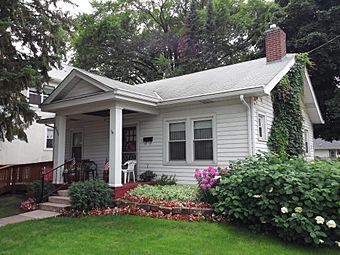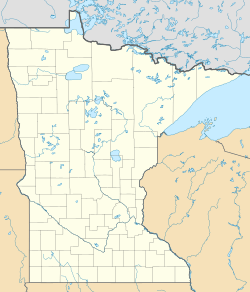Arthur and Edith Lee House facts for kids
Quick facts for kids |
|
|
Arthur and Edith Lee House
|
|

Arthur and Edith Lee House, 2014
|
|
| Location | 4600 Columbus Avenue South, Minneapolis, Minnesota |
|---|---|
| Area | less than one acre |
| Built | 1923 |
| NRHP reference No. | 14000391 |
| Added to NRHP | July 11, 2014 |
The Arthur and Edith Lee House is a special historic home in the Field neighborhood of Minneapolis, Minnesota. It was built in 1923. This house is important because it tells a story about fairness and standing up for what is right. It shows how one family fought against unfair rules and unkind treatment.
Contents
The Story of the Lee House
A New Home and a Big Problem
In June 1931, Arthur and Edith Lee, an African-American couple, bought this house. At that time, the area was mostly white. Many years before, in 1927, some neighbors had signed a special agreement. This agreement said they would not sell or rent their homes to people who were not white. These were called "exclusionary covenants."
When the Lees moved in July 1931, their new neighbors offered them more money to sell the house back. The Lees said no. After that, some neighbors started to bother them. They shouted mean things, put bad signs in their yard, and threw trash on their lawn.
Standing Strong: The Community Reacts
The situation got worse over the next few days. Crowds of hundreds, and later thousands, gathered. They kept shouting insults and throwing rocks at the house. Local police came to keep the peace. However, they did not offer much help to the Lees.
On July 16, the Minneapolis Tribune newspaper shared the story. Its front-page headline was "Home Stoned in Race Row." Arthur Lee, who had fought in World War I, was quoted in the article. He said, "Nobody asked me to move out when I was in France fighting in mud and water for this country. I came out here to make this house my home. I have a right to establish a home."
The newspaper story made even more people come to see what was happening. All the police in the city were called to form a line around the house. They made sure the streets nearby were not blocked by the crowd.
Fighting for Fairness: The NAACP Steps In
During this time, talks with neighbors and community leaders did not help. The Lees' lawyer even told them to say they would leave to calm things down. But the Lees were members of the local NAACP. This group helps African Americans fight for their rights.
They asked the NAACP for help. Lena O. Smith, the president of their NAACP chapter, offered legal help. She believed the Lees should stay. She thought it would show that they would not be scared away. The Lees agreed with her.
Lena Smith wrote a strong statement that was printed in all the local newspapers. It said that Mr. Lee "has no intention of moving now or later." This brave public statement, along with the strong police presence, helped stop the rioting.
A Lasting Legacy
The police stayed at the Lees' house for more than a year after the riots. The Lees' daughter was even walked to and from school by police officers. In 1934, the Lees moved from the house. They moved to the Central neighborhood, which was a historically black community.
People became interested in the house's history again in 2001. A law professor wrote an article about Lena O. Smith and her role in helping the Lees. Because of its importance to the story of African Americans and housing discrimination in Minneapolis, the house was added to the National Register of Historic Places in 2014. This means it is a special place that is protected for its history.
Images for kids




